
A stucco house finish is no longer limited to the Southwestern United States or Mediterranean locations. This versatile cement-like finish is now popular in various geographical areas and can be applied to masonry and wood-sheathed houses. In this ultimate design guide, we will explore the different aspects of a stucco house, including colors, cost, maintenance, and finish styles. So, let's dive in!
What Is a Stucco House?

A stucco house refers to the siding applied over the base exterior of a house. It offers numerous options in terms of textures, colors, and materials. Its seamless nature makes stucco houses resistant to damage from rain or snow, providing better protection than other sidings with seams. As long as homeowners properly maintain the stucco to prevent cracks, it proves to be a sturdy and durable siding option.
House Styles That Use Stucco
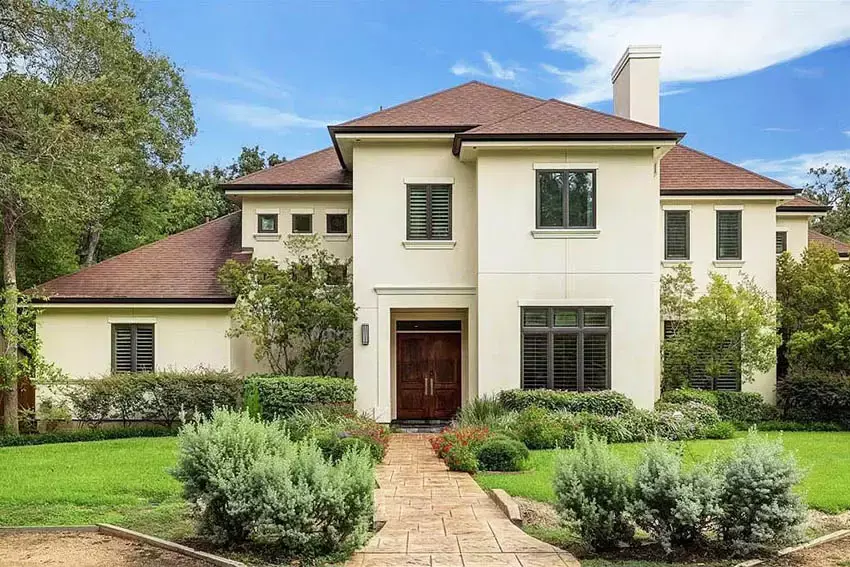
Stucco is commonly used in Mediterranean-style houses, which often feature arches, front columns, turrets, tall arched windows, and bay windows. These houses often have a mottled finish achieved through a smooth layer of stucco created using a pool trowel. Modern houses also make use of stucco, combining it with cedar and other types of wood accents. Additionally, contemporary houses with clean lines and boxy features can be enhanced by a stucco finish, adding a striking flair.
Stucco Benefits
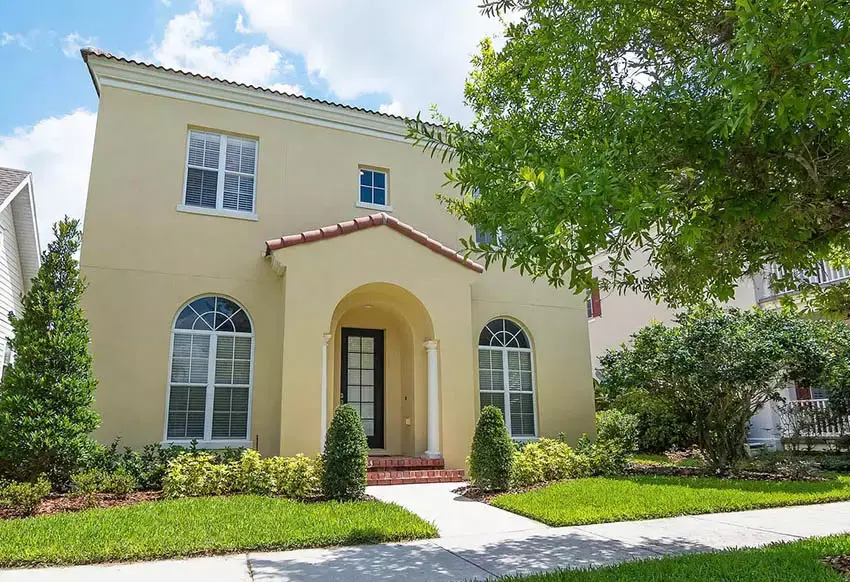
The use of stucco siding offers several benefits:
- Fire resistant: Stucco finishes are fire-resistant and can provide up to an hour of protection against fire penetration, making it an excellent choice for multi-family homes or houses built close together.
- Durable and long-lasting: Stucco is a durable finish that can last for decades, outlasting many other siding options.
- Energy efficient: Stucco helps in reducing energy bills by keeping air leaks at bay. Although traditional stucco has a relatively low R-value, newer synthetic stucco options provide better insulation.
Stucco Colors

Stucco finishes are available in a wide range of colors, allowing homeowners to match their home's style. While the base mixture is typically gray or white, pigments or tints can be added to create different colors. Tan, yellow, gold-toned whites, forest greens, pale sage colors, and ocean blues are popular choices. Modern stucco homes often feature base colors paired with different trim colors, creating a visually appealing contrast.
Common Colors of Modern Stucco Homes
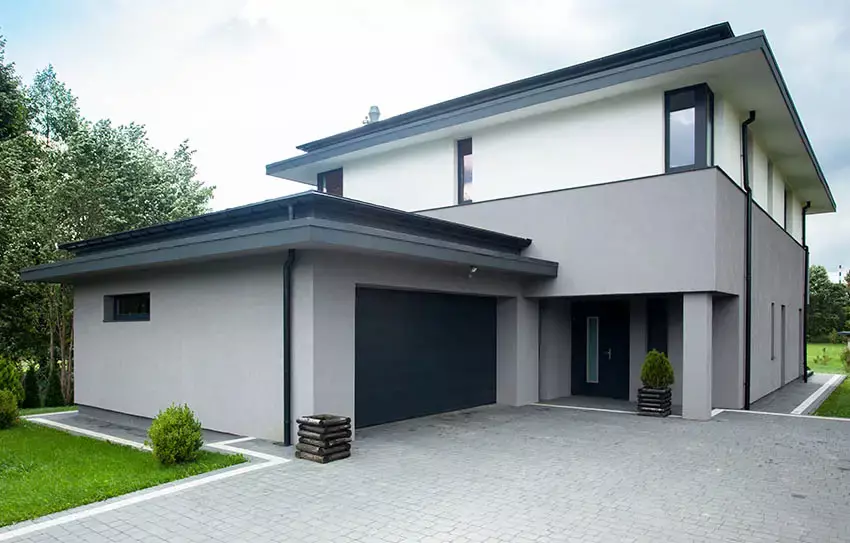
Modern stucco houses feature a variety of color combinations. Some popular options include a gray base with white trim, a stark black base with white trim, or a pure white base with black trim. Misty blue with deep, dark blue trim is another common choice for contemporary homes. Additionally, some homeowners opt for using two shades of color, dividing the walls into distinct sections.
Stucco House Finishes

Stucco offers various finishes that can enhance the look of your house. Let's explore some popular stucco finish styles:
Dash Finish (Roughcast Style)
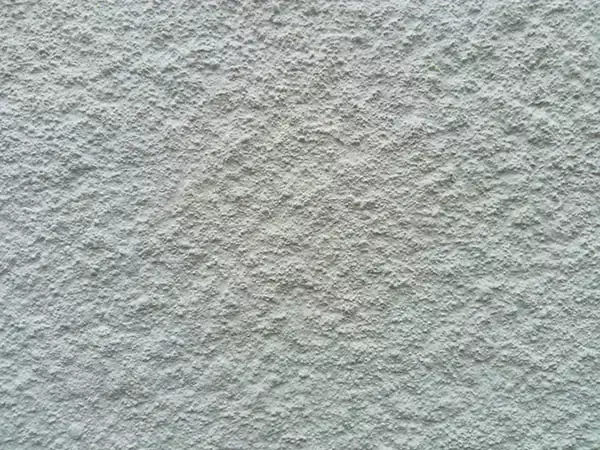
The dash finish, also known as roughcast, is a gravel-like textured finish that works well with any style home. It can be sprayed on using one to three coats for larger applications, or applied by hand with a trowel for smaller areas. This finish can be easily patched as long as the color matches correctly.
Sand Finish

The sand finish is commonly found on commercial buildings and is applied using a foam float. It requires only one coat for complete coverage, making it a quick process. The sand finish provides a textured surface with different grain sizes, hiding imperfections better than other finishes. It can be easily patched, as long as the original color can be matched.
Cat Face Finish (Montalvo)
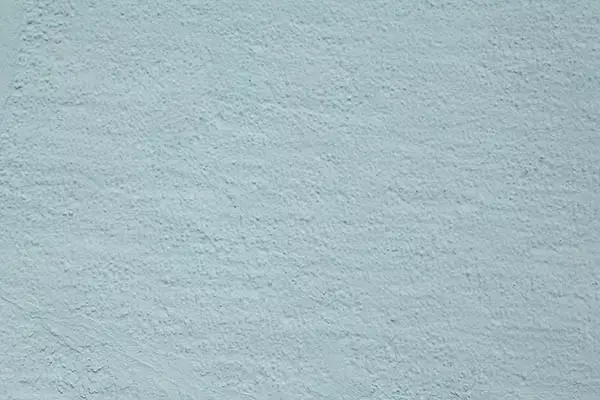
The cat face finish, also known as Montalvo or California finish, creates a pattern with a smooth surface dotted with rough areas called "inclusions." These rough spots resemble cat faces peering through the texture. This finish involves applying a rough coat followed by a smooth topcoat, leaving spots uncovered to reveal the rough undercoat. It works well with both traditional and synthetic mixtures.
Skip-Trowel Texture (Lace)
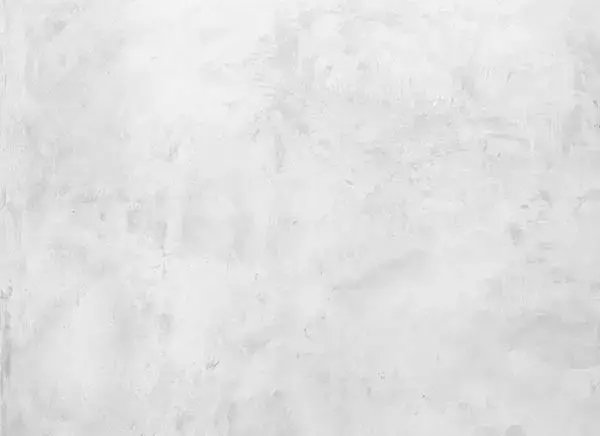
The skip-trowel texture, also known as lace, is a rough finish created with a base coat and a finished texture coat. The texture can be applied by hand or sprayed on and then flattened with a trowel to create a lace pattern. This finish is excellent for hiding imperfections and can be applied in fine, medium, or coarse grain patterns.
Smooth Finish

The smooth finish is aesthetically pleasing and increasingly popular. It can be achieved using a pool trowel, providing a smooth final layer. Synthetic stucco works better with this finish than traditional mixtures. To add a mottled design, colors can be applied during the application process. However, it's important to note that this finish may be more prone to cracking and can be more challenging to patch.
Santa Barbara Finish

The Santa Barbara finish, created using fine sand particles, offers an Adobe look when applied. Different colors of sand allow for variations in the finish, providing a very smooth and traditional style look. This finish only works with traditional stucco mix and typically involves applying two coats using a pool trowel.
Worm Finish
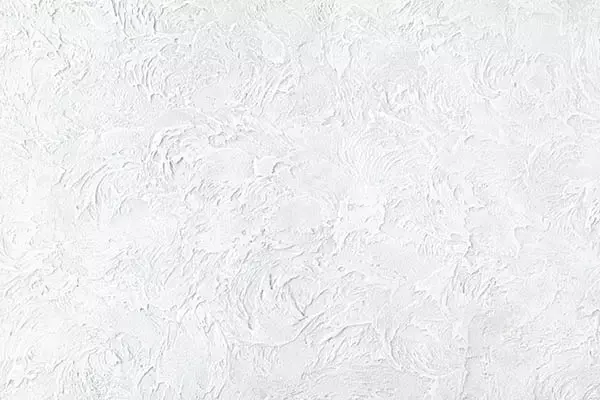
The worm finish, also known as a putz or swirl finish, creates an interesting visual design. This finish involves hand application and rubbing a plastic trowel in circular directions to create indents and lines resembling worms. Each application results in a unique design. It's important to note that stuccoed walls with a worm finish may be challenging to patch if they crack.
Types of Houses with Stucco Material

Stucco can be combined with various other materials to create dimension and appeal for different home styles. Here are some popular combinations:
Brick and Stucco
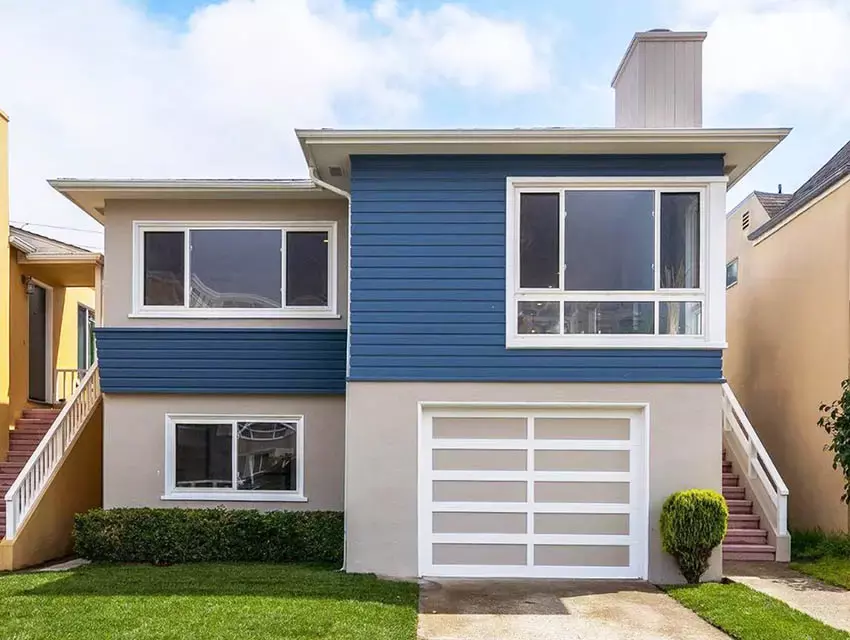
Combining brick siding with stucco creates stunning combinations. For example, a gabled home with gray textured siding, a red brick center build-out, and dark brown shutters can present an affluent look. Other options include using gray siding with black brick or gray wall finishes with gray brick for a charming and welcoming look.
Stucco and Siding

Stucco and siding can be combined to create eye-catching designs. Vinyl siding, the most common siding used in home building, is often paired with stucco to reduce costs and maintenance. When combining these two materials, it's essential to choose colors that match or complement each other.
Stone and Stucco
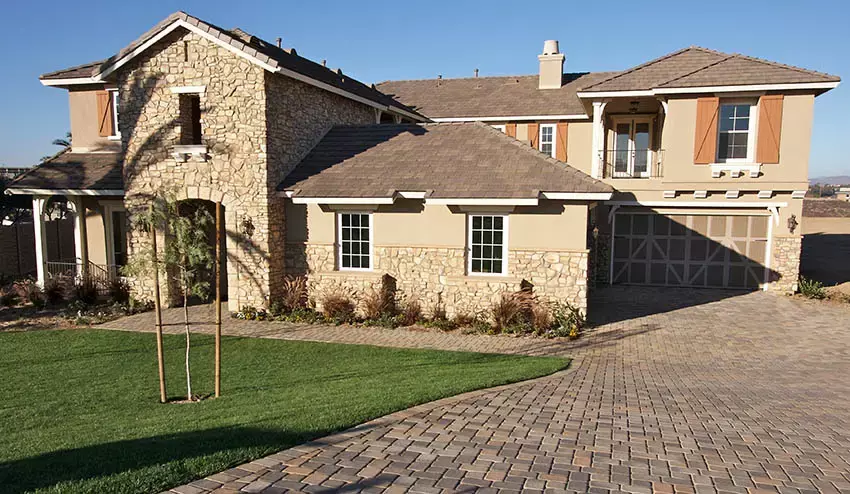
Stucco and stone create a sophisticated look when used together. The smooth texture of stucco complements the multi-faceted texture of stone, resulting in a visually appealing exterior. Homeowners often use stone for the bottom portion of the siding and stucco for the upper part, especially in peaks and gables.
Stucco and Wood

Combining stucco and wood siding is an excellent option for homeowners who want the aesthetic appeal of wood while reducing expenses and maintenance. Stuccoed walls with wood siding work well for homes in natural environments, such as wooded areas. The plaster can make up the bottom portion of the home, while wood complements the upper area.
Cost to Stucco a House
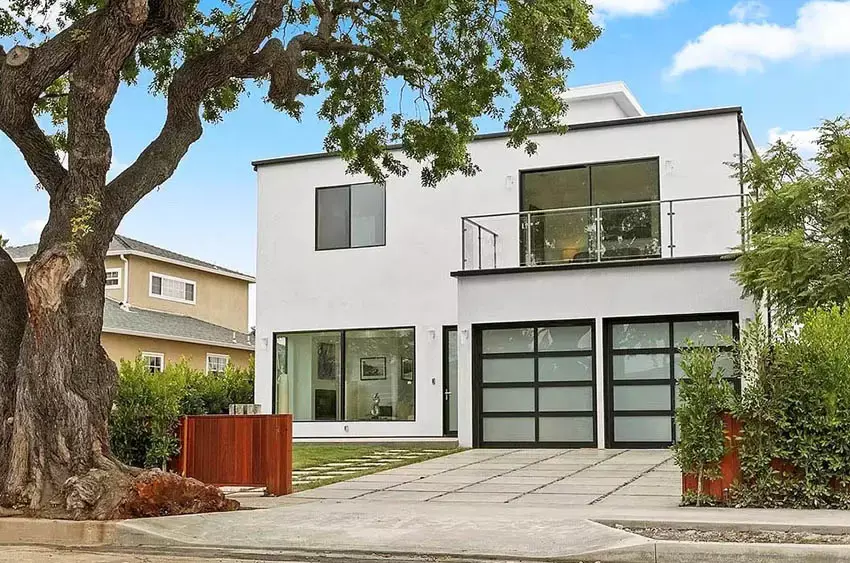
Stucco is a relatively expensive siding option compared to others. However, it offers long-term durability and benefits that offset the cost. The average cost of stucco in the US ranges from $4 to $10 per square foot. Factors such as location, supplies, equipment rental, and cleanup fees can affect the overall cost.
How to Stucco a House (Application Process)

Applying stucco to a house involves several layers and should be done with proper care. Here is a general outline of the application process:
- Ensure the surface has a rigid base such as plywood, cement board, or exterior-grade gypsum sheathing.
- Cover the surface with building paper, a rain screen, or roofing felt to provide additional protection.
- Attach metal or wood lath and add hardware, including metal control joints, to prevent future cracking.
- Apply the stucco mixture using a trowel or by spraying it on.
- Allow each layer to dry completely before applying the next layer. Most stucco applications require two to three coats.
There are different types of stucco application techniques, including traditional stucco, one-coat stucco, two-coat stucco, and synthetic stucco. Each technique has its own advantages and is suitable for specific situations.
Painting Stucco Houses
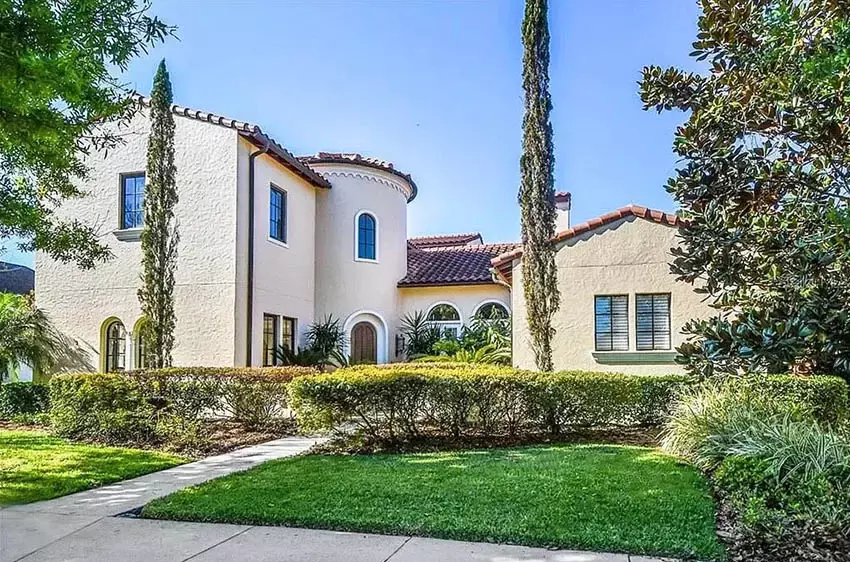
Stucco is a low-maintenance siding option, but over time, it may require painting to refresh its appearance. Before painting, it's essential to inspect the surfaces for any repairs that need to be done. Minor repairs can be handled using a plaster repair kit, while major repairs may require professional assistance. Once the repairs are complete, the walls should fully dry before priming and painting. Choosing the correct primer and applying it correctly is crucial to achieve a long-lasting finish.
Painting Costs
The cost of painting a stucco house depends on whether you choose to do it yourself or hire a professional. Here is an estimated breakdown of costs:
Do-it-Yourself Cost:
- Paint supplies: $2,000
- Labor: $0
- Repairs: $200
- Cleanup: $0
- Total: $2,200
Professional Cost:
- Paint supplies: $4,000
- Labor: $4,500
- Repairs: $1,400
- Cleanup: $750
- Total: $10,650
Keep in mind that these costs are estimates and may vary depending on factors such as location, supplies, and the extent of repairs required.
Stucco Maintenance & Care
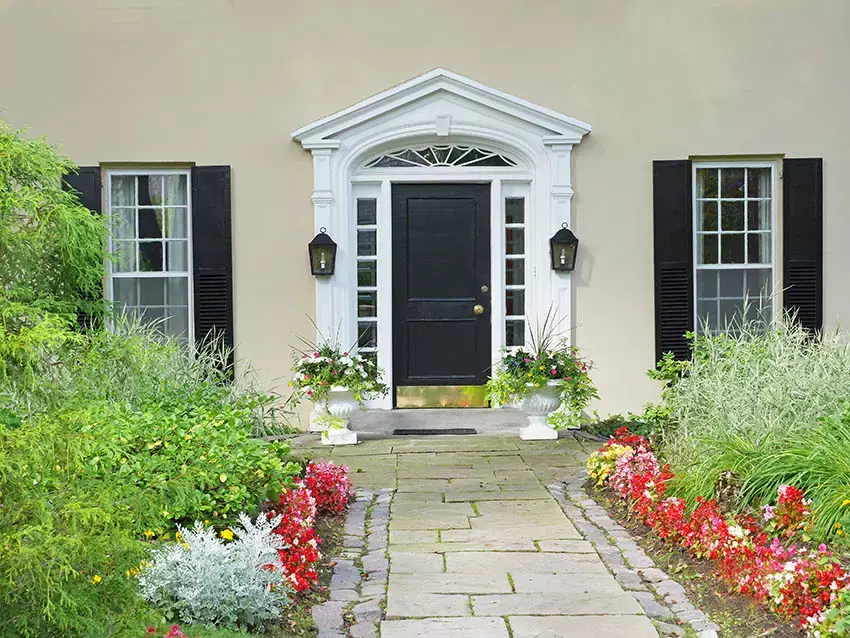
Proper maintenance is essential to keep your stucco siding in good condition. Regular cleaning and inspections are necessary. Cleaning can be done using a garden hose or a pressure washer, depending on the texture of the stucco. Inspections should be done at least once a year to check for any cracks, holes, or damage that may require immediate attention.
Issues with Plaster Cladding

While stucco is a durable siding option, there can be issues if it's not installed correctly or adequately maintained. Water, mold, termites, and shifting foundations can cause damage to the plaster. It's essential to have a professional inspection when buying a stuccoed house to ensure there are no hidden damages. With proper installation, maintenance, and repairs, stucco can last for several decades.
Conclusion
Stucco houses offer a wide range of design possibilities, durability, and unique finishes. Whether you're looking for a Mediterranean-style home, a contemporary design, or a combination of materials, stucco proves to be a versatile and attractive siding option. With proper care and maintenance, your stucco house can stand the test of time, providing a beautiful exterior for years to come.
For more design ideas and tips, be sure to explore our other articles!

















